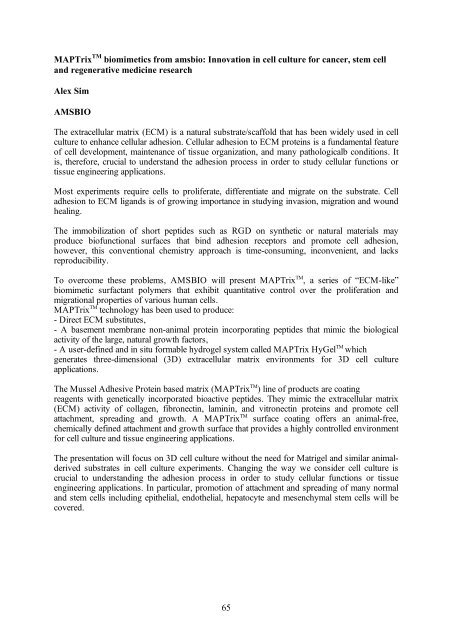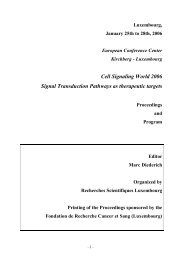Abstract book (download .pdf file) - Redox and Inflammation ...
Abstract book (download .pdf file) - Redox and Inflammation ...
Abstract book (download .pdf file) - Redox and Inflammation ...
You also want an ePaper? Increase the reach of your titles
YUMPU automatically turns print PDFs into web optimized ePapers that Google loves.
MAPTrix TM biomimetics from amsbio: Innovation in cell culture for cancer, stem cell<br />
<strong>and</strong> regenerative medicine research<br />
Alex Sim<br />
AMSBIO<br />
The extracellular matrix (ECM) is a natural substrate/scaffold that has been widely used in cell<br />
culture to enhance cellular adhesion. Cellular adhesion to ECM proteins is a fundamental feature<br />
of cell development, maintenance of tissue organization, <strong>and</strong> many pathologicalb conditions. It<br />
is, therefore, crucial to underst<strong>and</strong> the adhesion process in order to study cellular functions or<br />
tissue engineering applications.<br />
Most experiments require cells to proliferate, differentiate <strong>and</strong> migrate on the substrate. Cell<br />
adhesion to ECM lig<strong>and</strong>s is of growing importance in studying invasion, migration <strong>and</strong> wound<br />
healing.<br />
The immobilization of short peptides such as RGD on synthetic or natural materials may<br />
produce biofunctional surfaces that bind adhesion receptors <strong>and</strong> promote cell adhesion,<br />
however, this conventional chemistry approach is time-consuming, inconvenient, <strong>and</strong> lacks<br />
reproducibility.<br />
To overcome these problems, AMSBIO will present MAPTrix TM , a series of “ECM-like”<br />
biomimetic surfactant polymers that exhibit quantitative control over the proliferation <strong>and</strong><br />
migrational properties of various human cells.<br />
MAPTrix TM technology has been used to produce:<br />
- Direct ECM substitutes,<br />
- A basement membrane non-animal protein incorporating peptides that mimic the biological<br />
activity of the large, natural growth factors,<br />
- A user-defined <strong>and</strong> in situ formable hydrogel system called MAPTrix HyGel TM which<br />
generates three-dimensional (3D) extracellular matrix environments for 3D cell culture<br />
applications.<br />
The Mussel Adhesive Protein based matrix (MAPTrix TM ) line of products are coating<br />
reagents with genetically incorporated bioactive peptides. They mimic the extracellular matrix<br />
(ECM) activity of collagen, fibronectin, laminin, <strong>and</strong> vitronectin proteins <strong>and</strong> promote cell<br />
attachment, spreading <strong>and</strong> growth. A MAPTrix TM surface coating offers an animal-free,<br />
chemically defined attachment <strong>and</strong> growth surface that provides a highly controlled environment<br />
for cell culture <strong>and</strong> tissue engineering applications.<br />
The presentation will focus on 3D cell culture without the need for Matrigel <strong>and</strong> similar animalderived<br />
substrates in cell culture experiments. Changing the way we consider cell culture is<br />
crucial to underst<strong>and</strong>ing the adhesion process in order to study cellular functions or tissue<br />
engineering applications. In particular, promotion of attachment <strong>and</strong> spreading of many normal<br />
<strong>and</strong> stem cells including epithelial, endothelial, hepatocyte <strong>and</strong> mesenchymal stem cells will be<br />
covered.<br />
65




